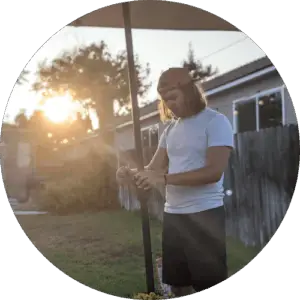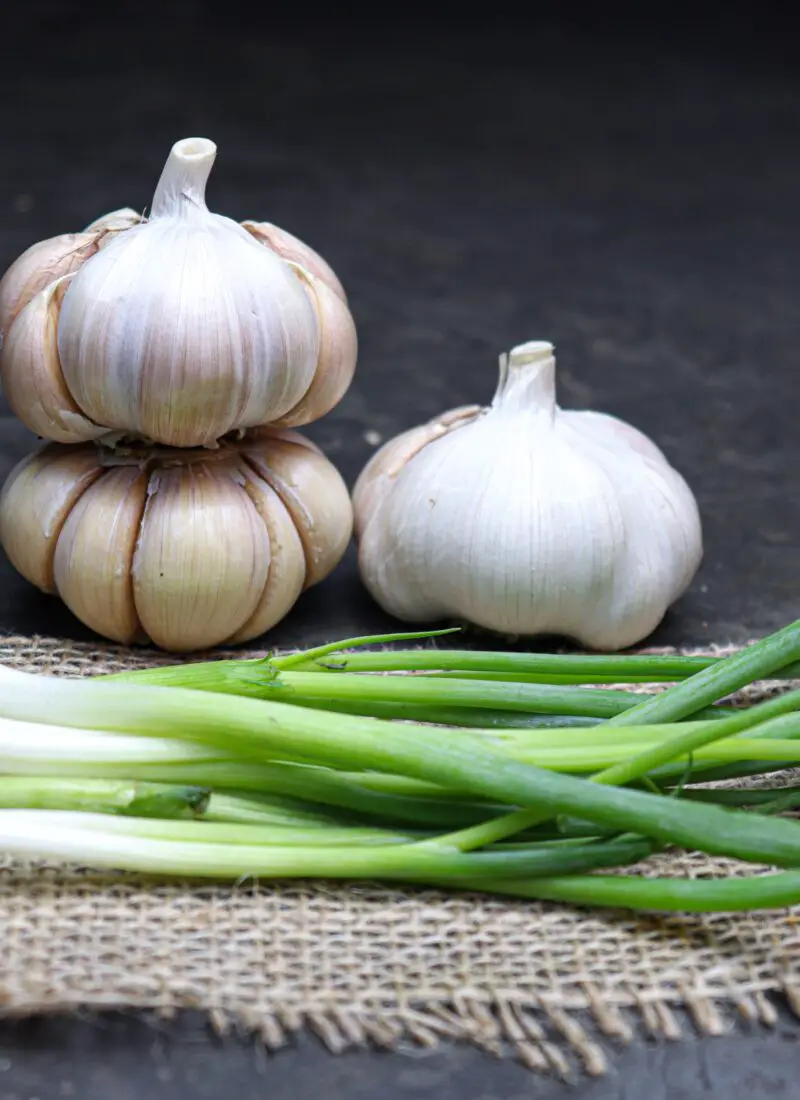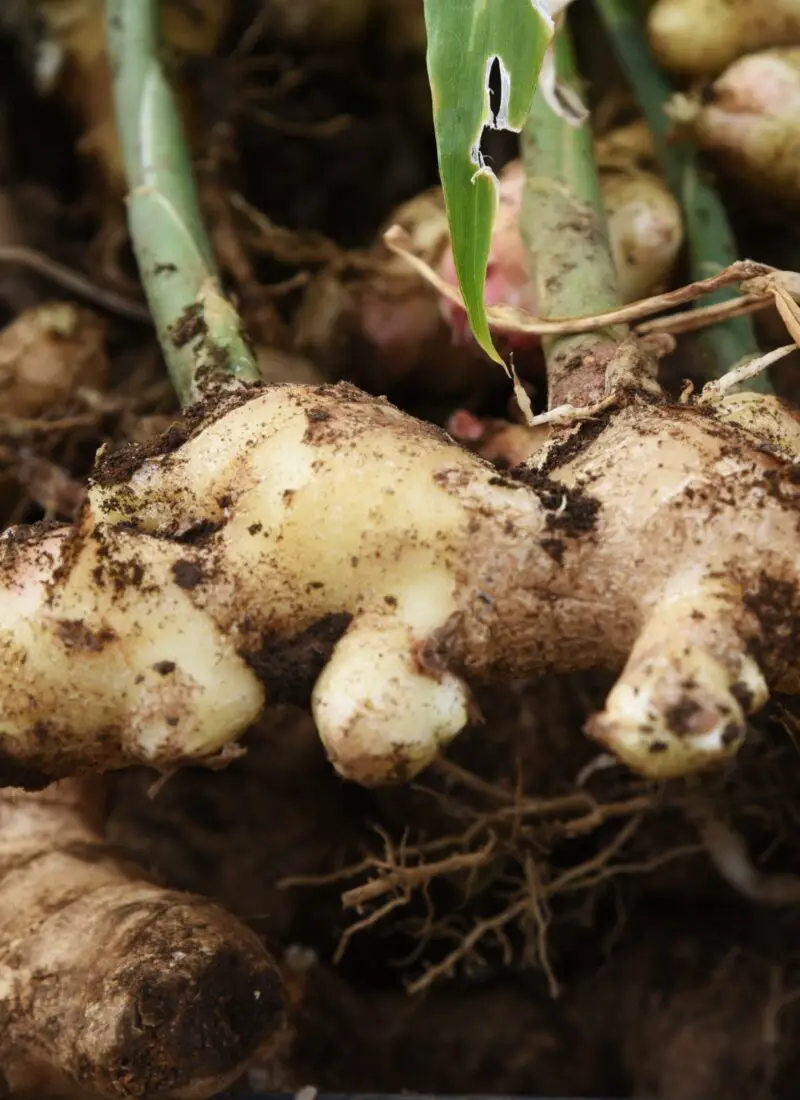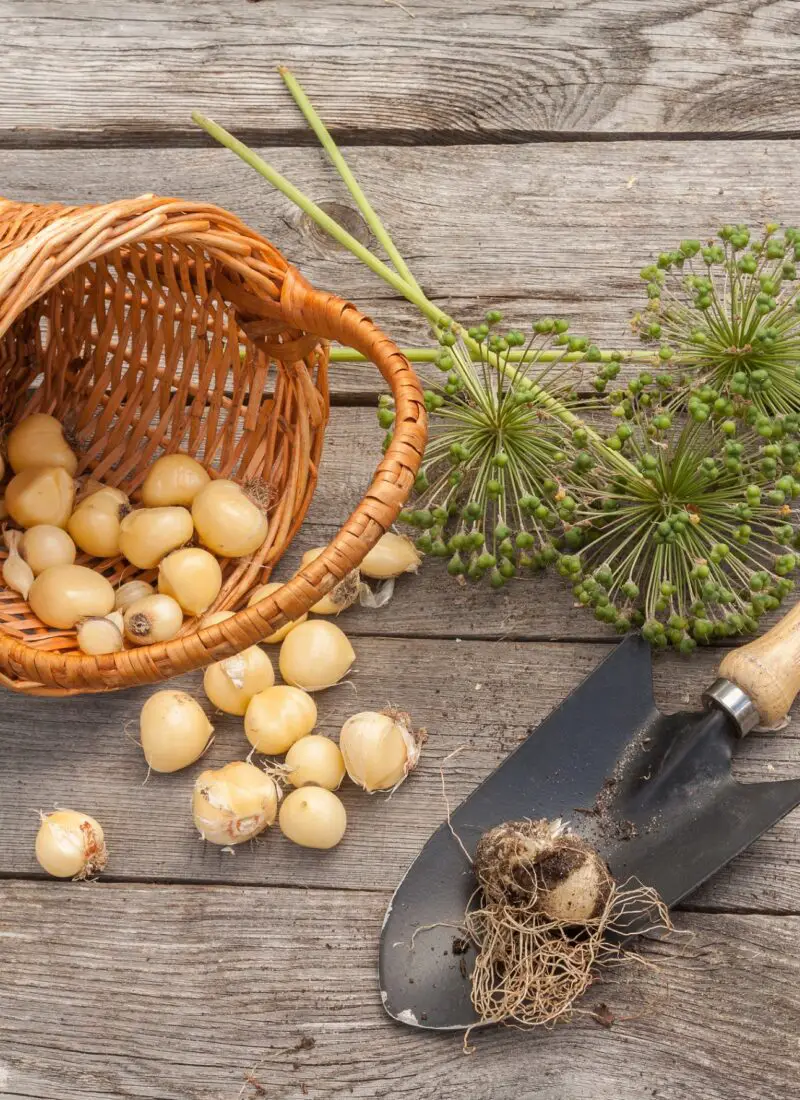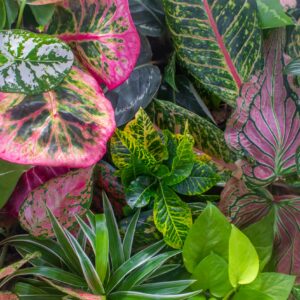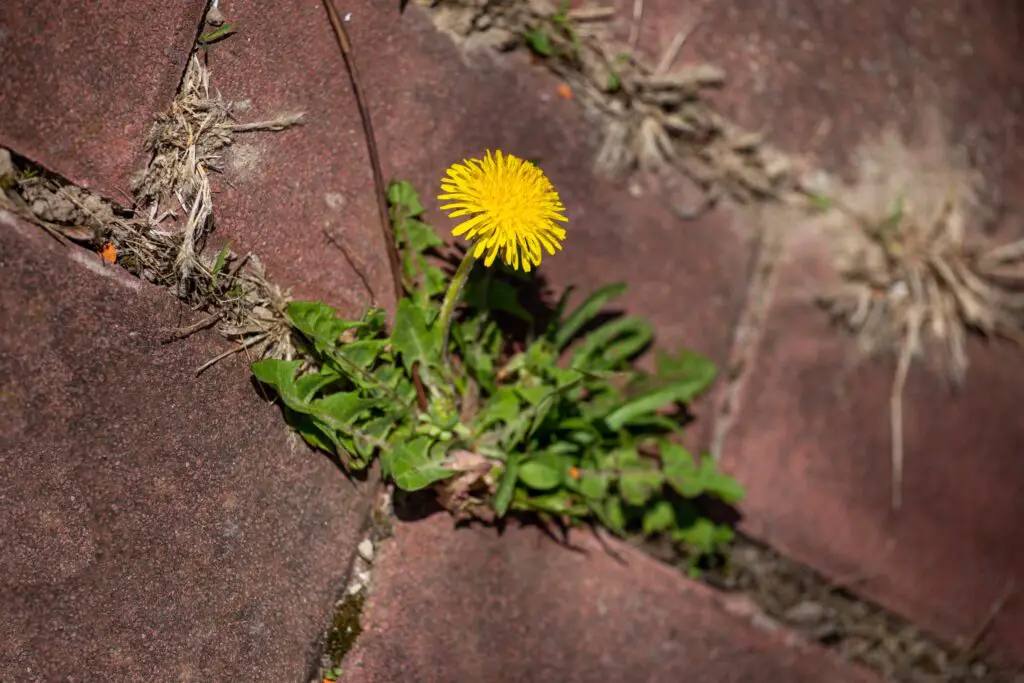
Weeds popping up in gardens are cute until you realize they’re sucking the nutrients away from your precious plants. At that point, it’s a matter of life or death for your green babies, especially if they are perennial.
But before we get into that list with tips on how to get rid of them, below is a brief introduction to the three main weed types you should know:
(As an Amazon Associate, I earn from qualifying purchases.)
Table of contents
- What are Perennial Weeds?
- 1. Dandelion (Taraxacum Officinale)
- 2. Plantain Weed/Broadleaf Plantain (Plantago Major)
- 3. Japanese Knotweed (Fallopia Japonica syn. Polygonum Cuspidatum)
- 4. Ground Ivy/Creeping Charlie (Glechoma Hederacea)
- 5. Yellow Nutsedge (Cyperus Esculentus)
- 6. Canada Thistle/Creeping Thistle (Cirsium Arvense)
- 7. Quackgrass (Elymus Repens)
- 8. Leafy Spurge (Euphorbia Esula L.)
- 9. Field Bindweed (Convolvulus Arvensis)
- 10. Common Reed (Phragmites Australis)
- 11. Ground Elder/Goutweed (Aegopodium Podagraria)
- Frequently Asked Questions About Perennial Weeds:
What are Perennial Weeds?
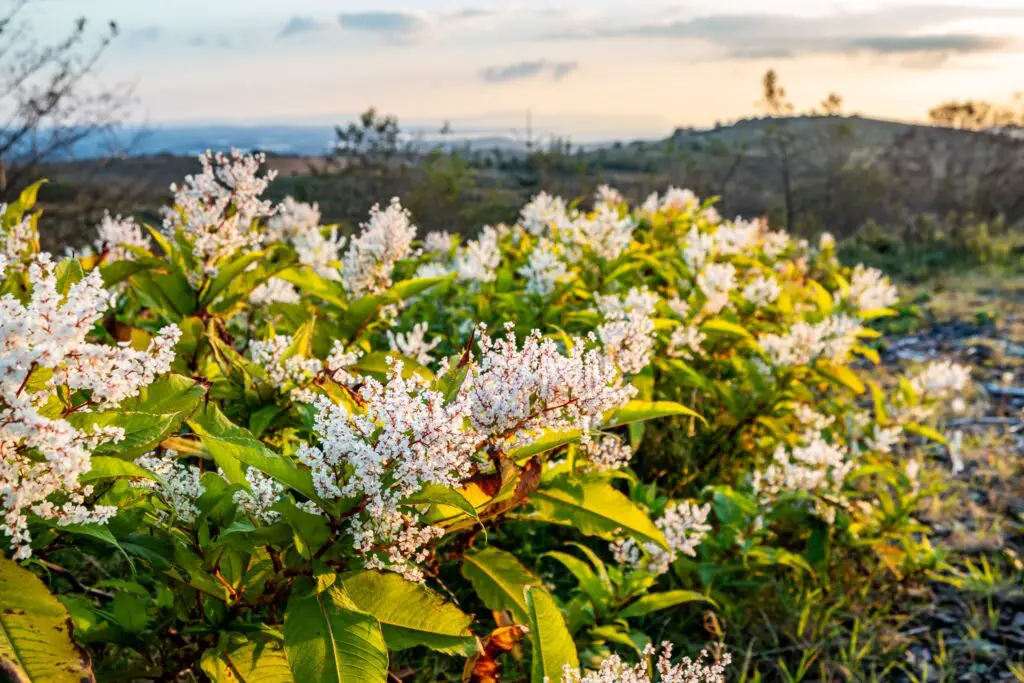
They are weeds that persist for over two years, often reproducing from thick tuberous roots like rhizomes and bulbs containing nutrient reserves. They can also sprout from stolons/runner vines that readily root upon contact with the ground. Some notable examples include dandelion, Canada thistle, and Japanese knotweed.
It’s notoriously difficult to eliminate this weed type, and it is instead controlled to prevent further spreading. It often requires two or more combinations of removal for several years, whether it be cultural (cultivating other plants or using livestock), mechanical (tilling, hoeing, flaming), or chemical (herbicide).
What are Annual Weeds?
They are plants that sprout, develop seeds, and die back within a year, beginning in summer or winter. Unlike perennial weeds, they are only spread by seed dispersal. A few examples of common annual weeds that tend to pop up are crabgrass, chickweed, and Japanese clover.
These are easy to remove from the garden or landscape. Simply hand-pull them out of the ground before they start to flower to prevent seeding. Follow this up with applying mulch over the area, about 3 to 4 inches in depth, and you’re good to go. If these pop up in your lawn, adjusting the mowing height higher, fertilizing, and watering correctly is enough to keep them from sprouting.
What are Biennial Weeds?
They are similar to annual weeds, except they develop in the first year before dying off in the second year after flowering and seeding. Some can even have deep taproots like perennial weeds but will still die after producing flower stalks. Several examples include burdock, Carolina false dandelion, and Queen Anne’s lace.
These can be removed similarly to annual weeds, with the additional effort of pulling out the whole root. Some gardeners also choose to spray them with herbicide for easier handling. But either way, each method is effective on its own.
With that said, here are 11 common perennial weeds you may have come across at least once before:
1. Dandelion (Taraxacum Officinale)
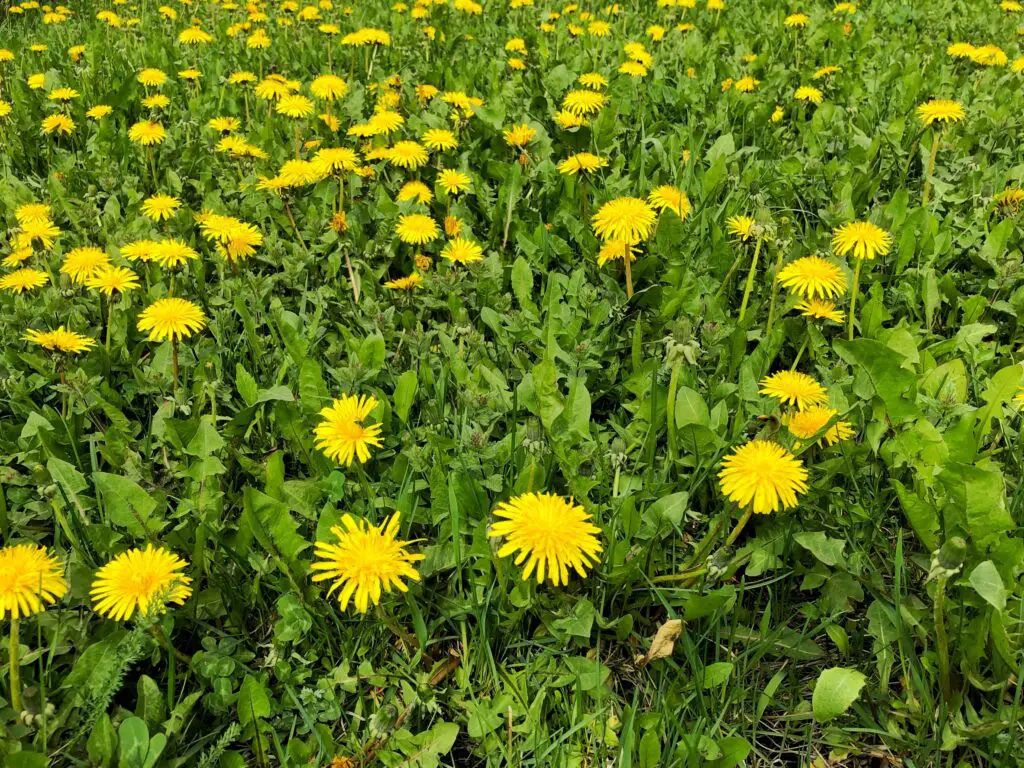
- Where is it often found?
- In poorly grown and managed lawns.
- In no-till fields.
- In compacted soil high in nitrogen and potassium.
- What are the characteristics of this weed for easy identification?
- Leaf type: Light green, whole or pointy leaves that resemble a spear’s tip. They grow in a rose-like formation, developing from the crown in the ground like a flower.
- Flower type: Bright yellow flowers with many petals, like daisies. These then develop into feathery white seed heads that the wind will carry.
- Root type: Deep, tap root that can extend up to 3 feet long in the ground.
- How to best get rid of this weed?
- Use garden tools to uproot the weed as much as possible. Try to gather broken root pieces to prevent the plant from growing again.
- Broadleaf weed killer isn’t as effective because it will only get rid of the leaves but not the roots. It will also affect other plants in the vicinity.
- Any precautions about handling this weed? Wear gloves when handling the weed by hand to prevent irritating your skin from the milky sap.
2. Plantain Weed/Broadleaf Plantain (Plantago Major)
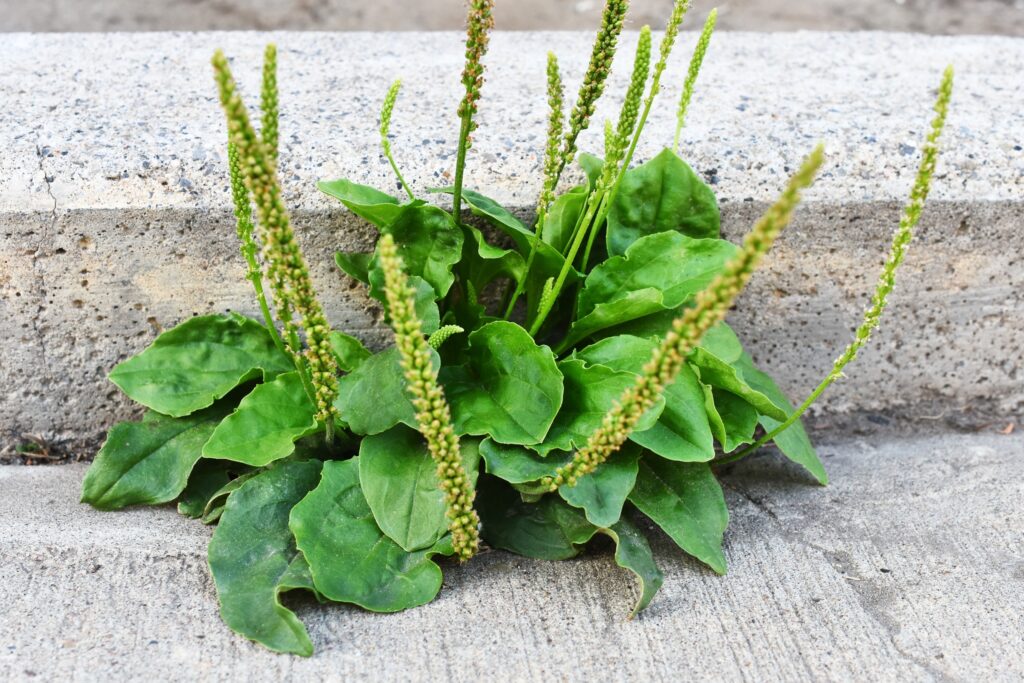
- Where is it often found? In moist, compacted soil high in calcium.
- What are the characteristics of this weed for easy identification?
- Leaf type: Light green, smooth and rounded leaves that turn dark green, crinkled, and narrow as it matures. It grows in a rose-like formation, lying flat on the ground.
- Flower type: Inflorescence, i.e., clusters of white, tiny flowers on bumpy stalks growing from the center of the plant. These then turn into capsules containing black/brown seeds.
- Root type: Fibrous roots, i.e., multiple roots growing just below the soil’s surface.
- How to best get rid of this weed?
- Remove flower stalks as soon as they appear to prevent seeding.
- Dig out the whole plant along with its roots.
- Apply landscape fabric or mulch about 3-4 inches in thickness.
- Using herbicide is only effective when applied to young versions of this weed to suppress it, but not completely eliminate it.
- Any precautions about handling this weed? Other similar-looking species of this weed include Buckhorn Plantain (Plantain Lanceolata) and Blackseed Plantain (Plantago Rugeli). They belong to the same family and should be handled and removed the same way as a common Plantain Weed.
3. Japanese Knotweed (Fallopia Japonica syn. Polygonum Cuspidatum)
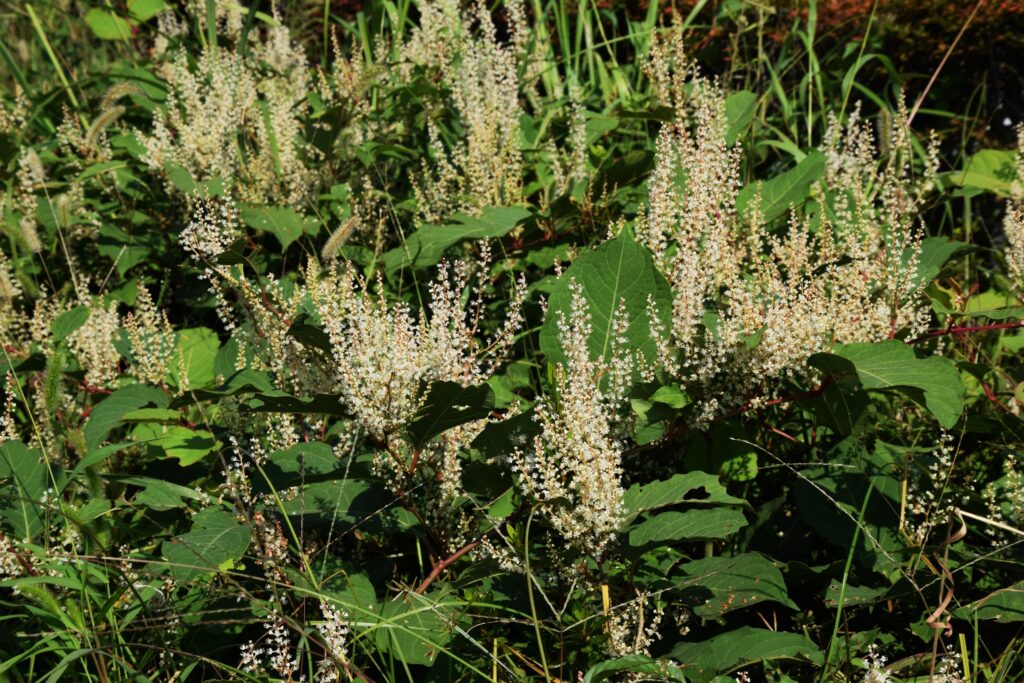
- Where is it often found? In areas with wet soil and full sun exposure, such as near streambeds or even puddles next to a road.
- What are the characteristics of this weed for easy identification?
- Leaf type: Rounded heart-shaped leaves that are dark green at the top and light green on the underside. They grow on long stems that can be up to 15 feet tall!
- Flower type: Clusters of tiny white-green flowers on thin stems growing from the same node, i.e., leaf stalk.
- Root type: Rhizomatous, i.e., thick roots that grow horizontally and extensively up to 65+ feet with multiple fibrous roots.
- How to best get rid of this weed?
- Uproot the entire weed, collecting as many broken root pieces as possible to prevent it from resprouting.
- Alternatively, you can use livestock like goats to graze on the weeds’ foliage. But you must immediately follow it up with root removal to prevent it from growing again.
- After removing the roots, apply 3-4 inches of mulch around the area.
- Any precautions about handling this weed? You’ll likely have to keep removing the weeds for several years as it is almost impossible to get rid of. But so long as you catch it early, it’ll be manageable.
4. Ground Ivy/Creeping Charlie (Glechoma Hederacea)

- Where is it often found? In shady areas with moist soil; they can sometimes be found in sunny spots.
- What are the characteristics of this weed for easy identification?
- Leaf type: Light green, kidney-shaped leaves with circular, bumpy edges growing on long, thin stems.
- Flower type: Tubular-shaped, purple-bluish flowers with red markings.
- Root type: Fibrous roots, i.e., multiple roots growing just below the soil’s surface. It also sends out stolons/runner vines that readily root upon contact with the ground.
- How to best get rid of this weed?
- Improve the soil conditions by aerating it with a rake or till, amend the soil as needed with Nitrogen fertilizers, and grow shade-tolerant plants to outcompete the weed’s growth.
- Alternatively, use herbicide containing triclopyr on a cool and still day. Wear goggles, a mask, and protective clothing when handling chemicals.
- Any precautions about handling this weed? When crushing the leaves, a minty odor is noted that may be unpleasant to some people.
5. Yellow Nutsedge (Cyperus Esculentus)
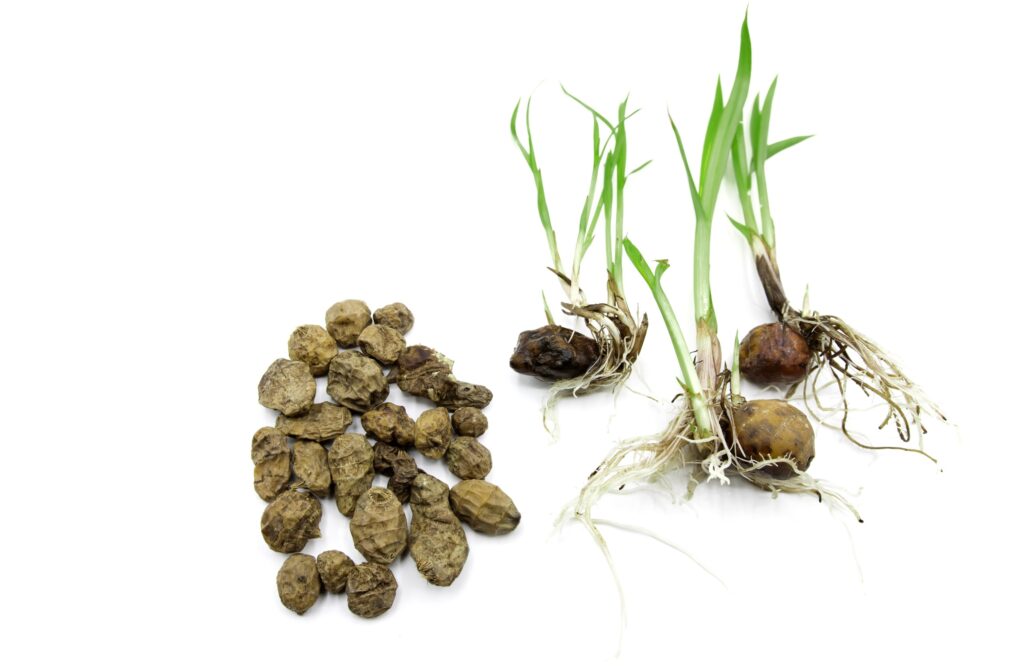
- Where is it often found? In areas with wet and poor soil drainage. Once it is established, it can spread to nearby, well-draining spaces.
- What are the characteristics of this weed for easy identification?
- Leaf type: Glossy, greenish-yellow, long and narrow leaf with a tapered end; often arranged in threes and developing on slightly thick, triangular stems.
- Flower type: No flowers. But they do produce short golden spikelets/seedheads.
- Root type: Rhizomatous, i.e., thick roots which grow tubers/nutlets that can stay dormant in the soil up to 10 years!
- How to best get rid of this weed?
- Uproot the entire weed, ensuring to collect the tubers/nutlets to prevent it from sprouting again.
- Improve the soil conditions by aerating it with a rake or till to prevent compaction and to water infrequently. It’s also advisable to increase mowing height to ensure the turfgrass’s growth outcompetes the weeds’ development.
- Any precautions about handling this weed? Purple nutsedge may be mistaken for Yellow nutsedge due to its similar look. But the former has dark green leaves with a blunt tip and produces purple or brownish-red spikelets/seedheads. They also develop more tubers/nutlets along the length of the rhizomatous roots. But luckily, they can be dealt with the same as Yellow nutsedge.
6. Canada Thistle/Creeping Thistle (Cirsium Arvense)
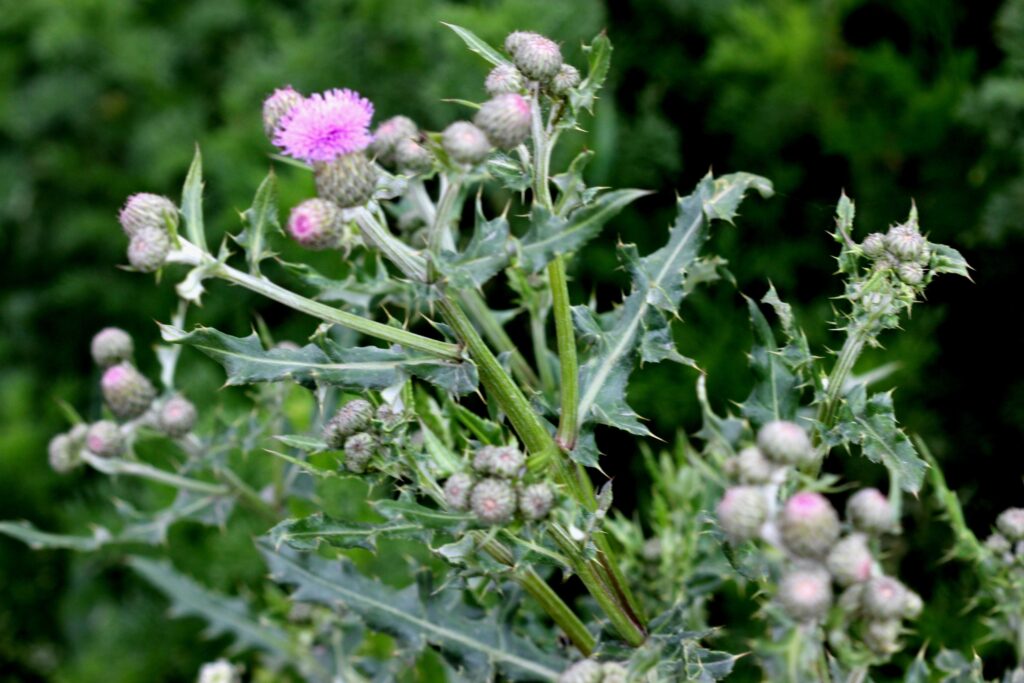
- Where is it often found? It’s everywhere but usually starts from disturbed grounds, i.e., overgrazed, bare, or abandoned areas where the topsoil is removed or modified.
- What are the characteristics of this weed for easy identification?
- Leaf type: Dark green, smooth leaves with toothy edges and rounded to pointy shield-shaped tips.
- Flower type: Flute-shaped (the wineglass, not the instrument), scented flowers that come in purple, pink, or white. The male flowers are more rounded and don’t have a fragrance.
- Root type: Deep, tap root that can extend up to 6 feet long in the ground with multiple fibrous roots growing horizontally below the surface.
- How to best get rid of this weed?
- Use herbicide containing aminopyralid or clopyralid during the weeds’ early bloom stage in late spring to early summer. If you missed this window, fall is also acceptable. Repeated application is needed for the next 1-3 years.
- Cut the thistles down either by mowing or using a garden scythe after chemical application.
- As an option, you can also cultivate alfalfa within the same area until it matures so it can suppress the thistles from sprouting back up.
- Any precautions about handling this weed? Canada thistle requires years of consistent effort to control as it is also almost impossible to eliminate completely. The best you can do is manage it and grow something in place, like alfalfa or grass, to outcompete it.
7. Quackgrass (Elymus Repens)
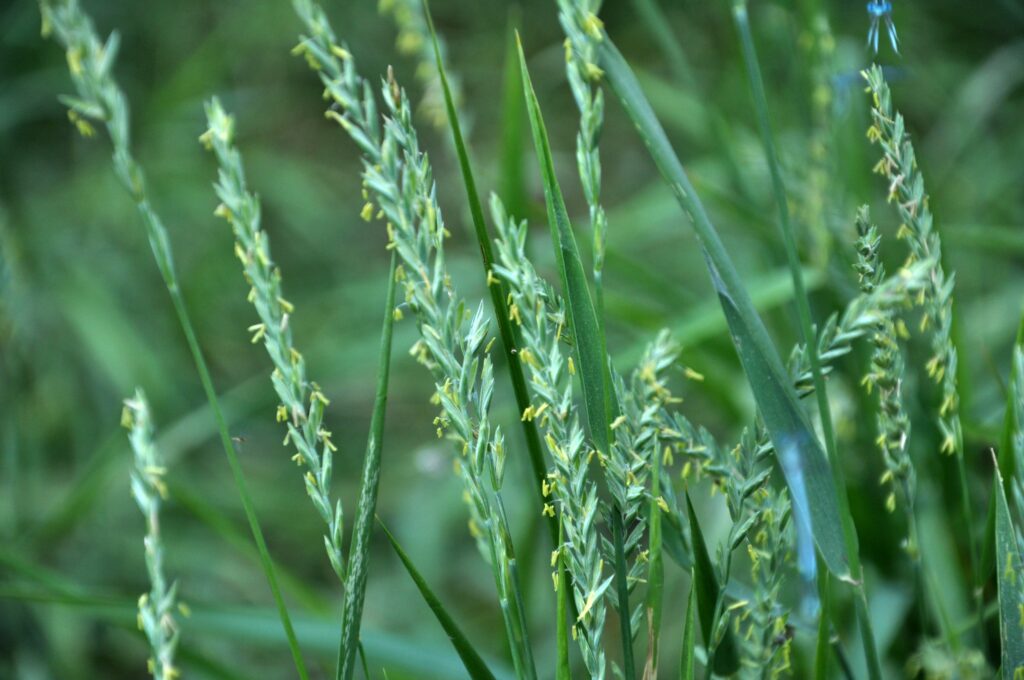
- Where is it often found? In nutrient-rich areas that may or may not have been tilled.
- What are the characteristics of this weed for easy identification?
- Leaf type: Greenish-blue, smooth, narrow leaf blades reaching 12 inches long.
- Flower type: No flowers. But they do produce seedheads with multiple spikes on each stem.
- Root type: Rhizomatous, i.e., thick roots that grow horizontally and extensively.
- How to best get rid of this weed?
- Use herbicides containing glyphosate to manage the weeds’ growth. Apply it three or more times, but only after letting them grow a bit for easier handling.
- Tilling or uprooting the weed is not recommended, as the rhizomatous roots will just spread when broken into pieces.
- Any precautions about handling this weed? None!
8. Leafy Spurge (Euphorbia Esula L.)
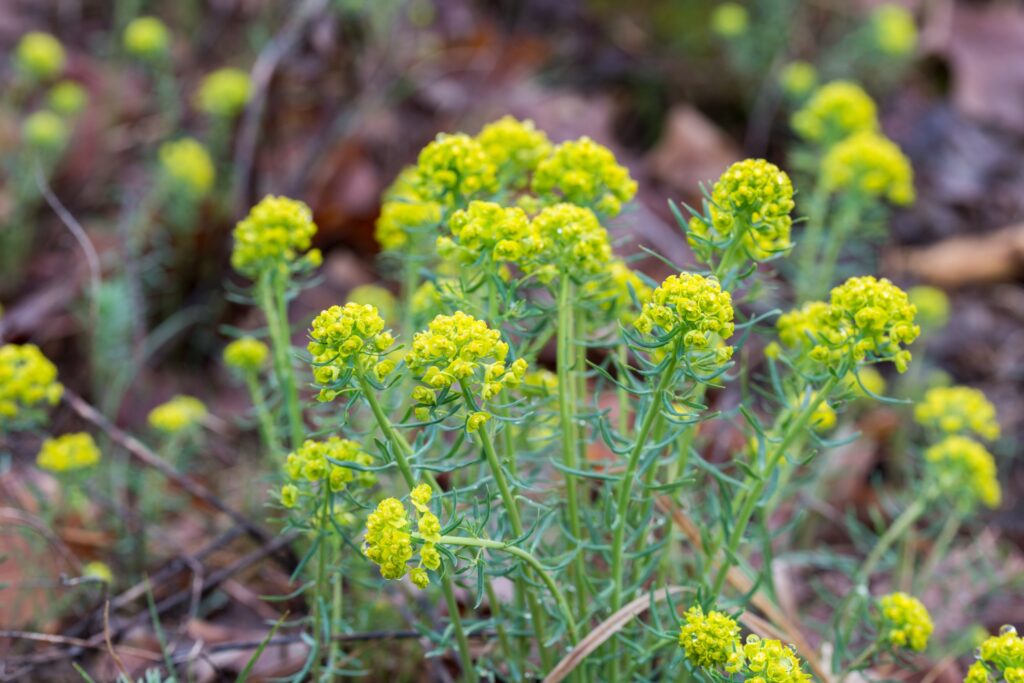
- Where is it often found? It is everywhere but typically grows more rapidly in areas with dry soil.
- What are the characteristics of this weed for easy identification?
- Leaf type: Dark green, long, and lance-shaped leaves about 1 to 4 inches long.
- Flower type: Clusters of 7 to 10 greenish-yellow, heart-shaped flowers in an upside-down umbrella formation.
- Root type: Deep, tap root that can extend up to 15 to 30 feet long in the ground, producing several buds along the way.
- How to best get rid of this weed?
- Use herbicide containing glyphosate once a month starting in early summer to control the weeds’ growth.
- By fall, plant grass seeds to ensure they grow next spring and outcompete the weeds.
- Any precautions about handling this weed? The stems excrete an irritating milky sap once broken. Be careful when handling this, and keep it away from your livestock and pets.
9. Field Bindweed (Convolvulus Arvensis)
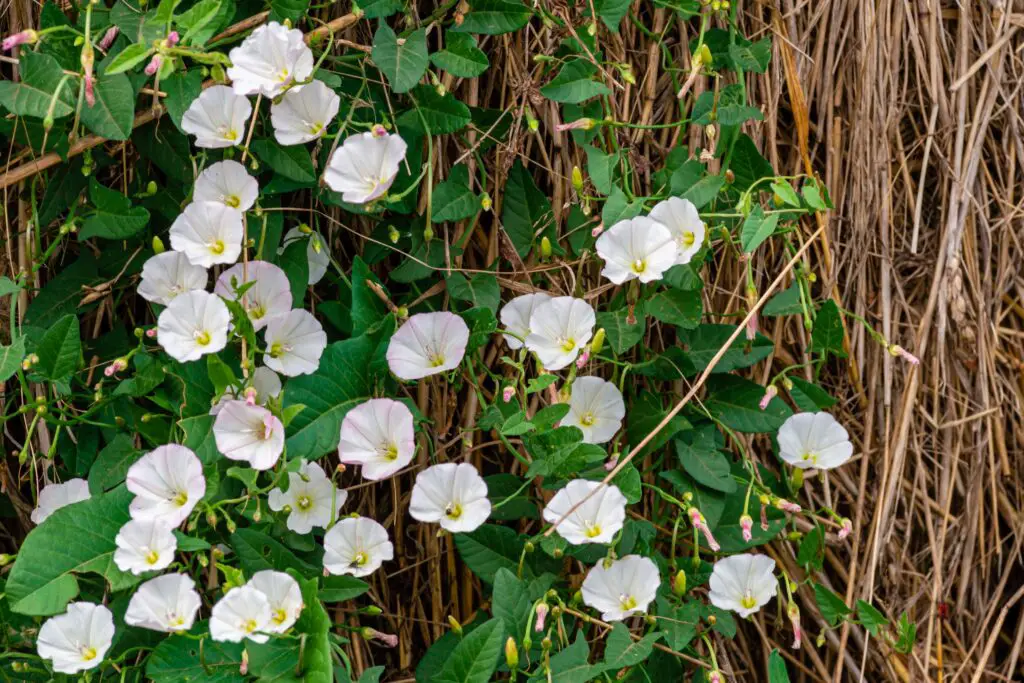
- Where is it often found? Everywhere from farm fields to home gardens and landscapes in the city.
- What are the characteristics of this weed for easy identification?
- Leaf type: Arrow or spade-shaped leaves growing along a trailing vine.
- Flower type: White or pink trumpet-shaped flowers that resemble Morning glories.
- Root type: Rhizomatous, i.e., thick roots that grow horizontally and extensively up to 33 feet.
- How to best get rid of this weed?
- Spot spray the weeds with a herbicide containing glyphosate on a cool and still day, being careful to prevent it from getting on other plants. Wear gloves, a mask, and protective clothing during the process.
- Uprooting the weed is not efficient due to the extensive root system. Any broken pieces left behind can also readily sprout new growth.
- Any precautions about handling this weed? Once field bindweed sets in your garden, it’s nearly impossible to get rid of it. Dormant seeds in the ground can still develop even after 50 years! So the best way to manage it is to control its growth.
10. Common Reed (Phragmites Australis)
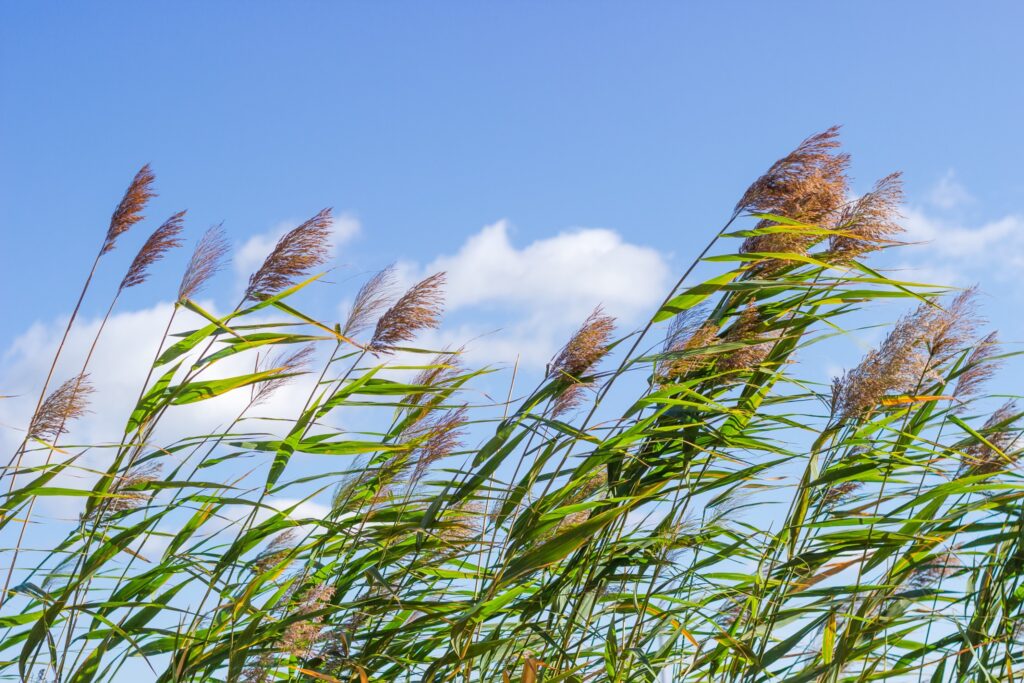
- Where is it often found? In areas near wetlands, regardless of whether they were brackish or freshwater.
- What are the characteristics of this weed for easy identification?
- Leaf type: Dark gray or blue-ish green, flat leaves growing on long and rough stems.
- Flower type: Feathery clusters of brownish-white.
- Root type: Rhizomatous, i.e., thick roots that grow horizontally and extensively.
- How to best get rid of this weed?
- Cut the weeds down mid to late summer using hedge trimmers or lawnmowers.
- Then apply black plastic over the patch of land, weighing it with rocks and sandbags. Ensure direct sunlight is shining down onto the plastic to increase the temperature inside and kill off the remaining weeds. Pull out any that may sprout by hand after removing the plastic.
- Alternatively, apply herbicide containing glyphosate once the weeds grow back up to 2-3 feet tall in the fall.
- Any precautions about handling this weed? There is a native species of this weed in the US, and it looks pretty similar, except that it is more greenish-yellow with small black spots on the stems. Be sure to identify them correctly from the non-native weedy ones before removing them.
11. Ground Elder/Goutweed (Aegopodium Podagraria)
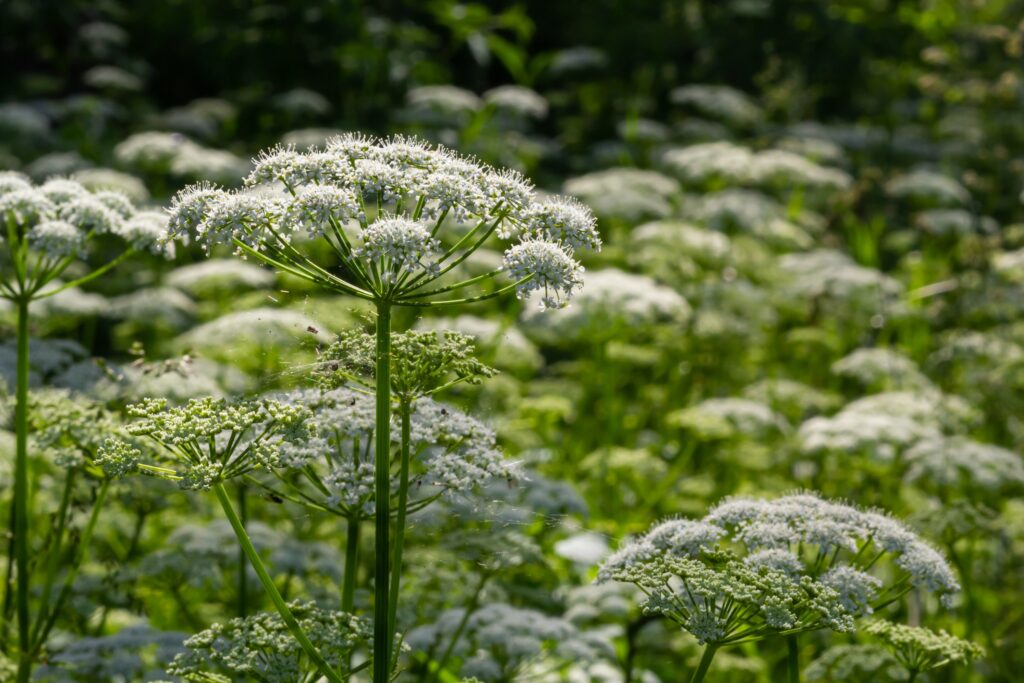
- Where is it often found? In areas with disturbed ground disturbed grounds, i.e., bare or abandoned sites where the topsoil is removed or modified.
- What are the characteristics of this weed for easy identification?
- Leaf type: Bluish-green or variegated, arrow-shaped leaves with serrated edges arranged in threes.
- Flower type: Clusters of tiny, white flowers arranged in an umbrella formation.
- Root type: Rhizomatous, i.e., thick roots that grow horizontally and extensively.
- How to best get rid of this weed?
- Using garden tools, carefully uproot the entire weed, collecting broken pieces to prevent them from resprouting.
- Then apply black plastic over the area, weighing it with rocks. Ensure direct sunlight is shining down onto the plastic to increase the temperature inside and prevent any regrowths. Pull out any weeds that may sprout by hand after removing the plastic.
- Any precautions about handling this weed? None!
Frequently Asked Questions About Perennial Weeds:
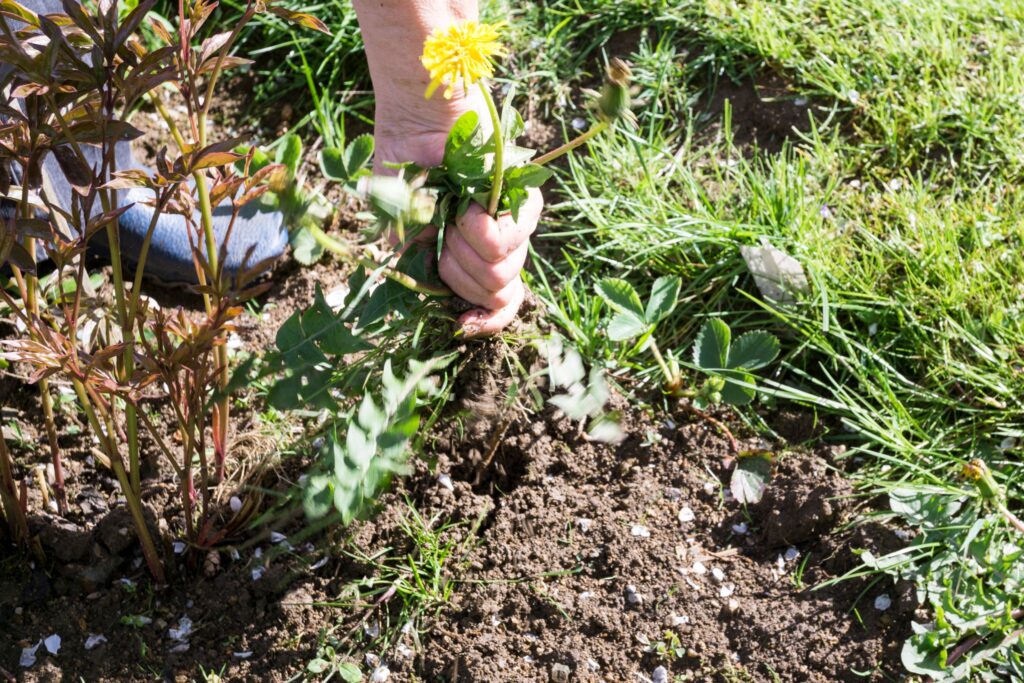
Early spring, right before it starts flowering or in late fall, for hand-pulling, digging them out, or applying herbicide. Annual and biennial weeds are easier to remove because they can be eliminated with either method. But perennial weeds will require specific handling, a combination of ways, and repeated efforts for 3 to 4 years, sometimes more.
A weed whacker is ineffective in eliminating weeds as it doesn’t prevent dropped seeds or broken root pieces in the ground from resprouting. Essentially, it only removes the top foliage but not the underground reserves. This is even more obvious with perennial weeds, which often require a follow-up herbicide application to control the regrowth.
Applying a 3 to 4-inch layer of mulch over the ground helps suppress weed growth, provided it has been pulled out beforehand. Ensure to top up every few months if you’re using the organic type, like shredded bark or wood chips, as this will decompose over time. Any weeds that sprout up through the mulch layer can be easily removed while they are still young.
Plantain weed, dandelion, field bindweed, Canada thistle, ground ivy, and Japanese knotweed are some examples of broad-leafed or non-grass perennial weeds. There are also annual weeds, such as chickweed and Japanese clover, that are broad-leafed. These typically have flowers and more than two leaves, which is significantly different from grassy weeds.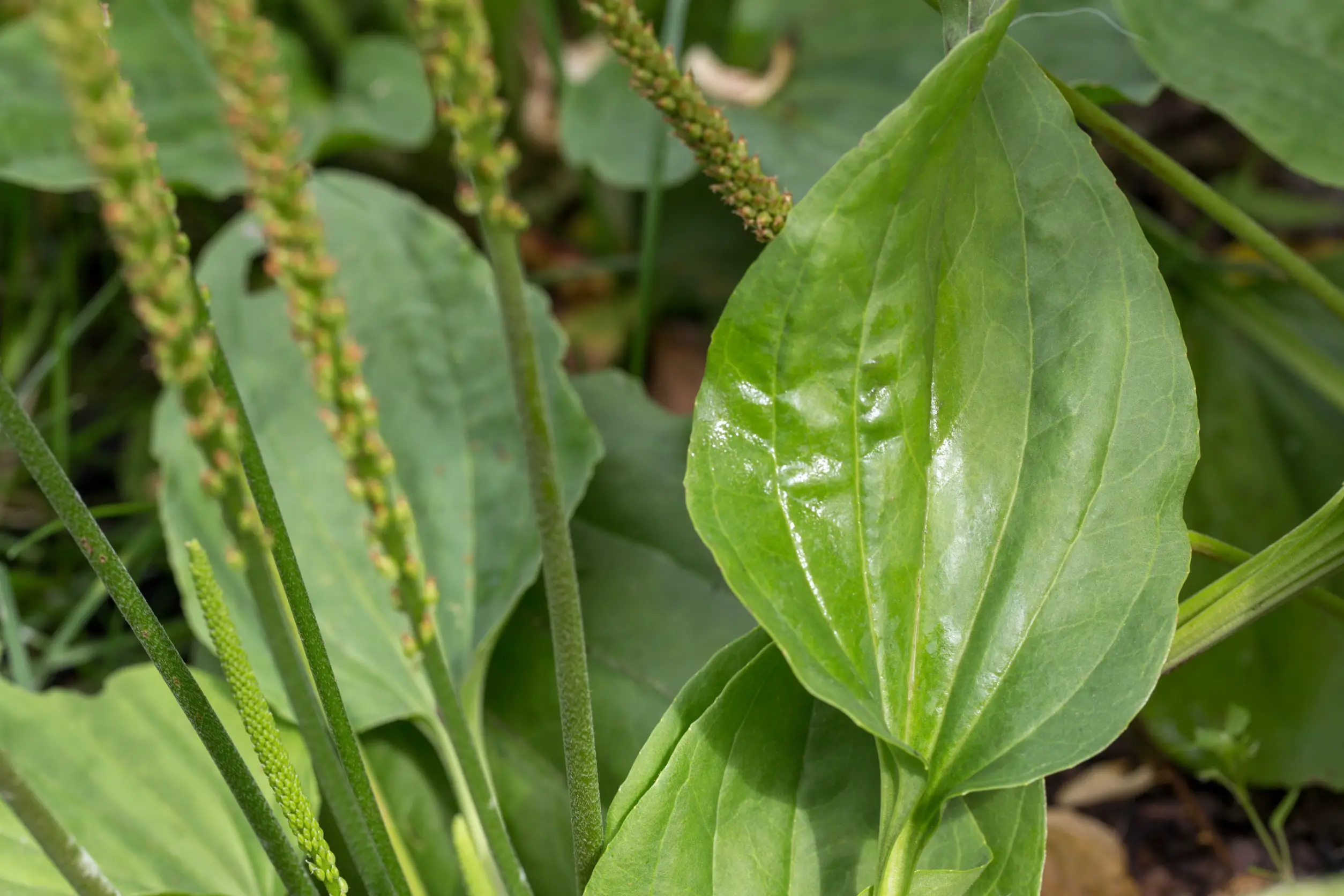
Cutting the weeds down to the ground, followed by solarization, i.e., securing black plastic over the area under direct sunlight, can help kill them off. The temperature underneath will increase to suppress their growth. However, this may not work for perennial weeds with rhizomes or tuberous roots that will sprout again. In this case, using herbicide is more efficient in managing their development.
Not all weeds are perennial, as some are annual and biennial. This means there are weeds with only a 1 to 2-year lifespan before they die back to the ground after seeding. However, perennial weeds continue to grow over two years, constantly spreading by seed dispersal and rhizomes.
Crabgrass is a summer annual weed, germinating as soon as the soil warms up in late spring or early summer. These last until the fall season before dying back due to the frost. Luckily, these are easily removed by uprooting from the ground and reseeding the area with better plants or grass growth.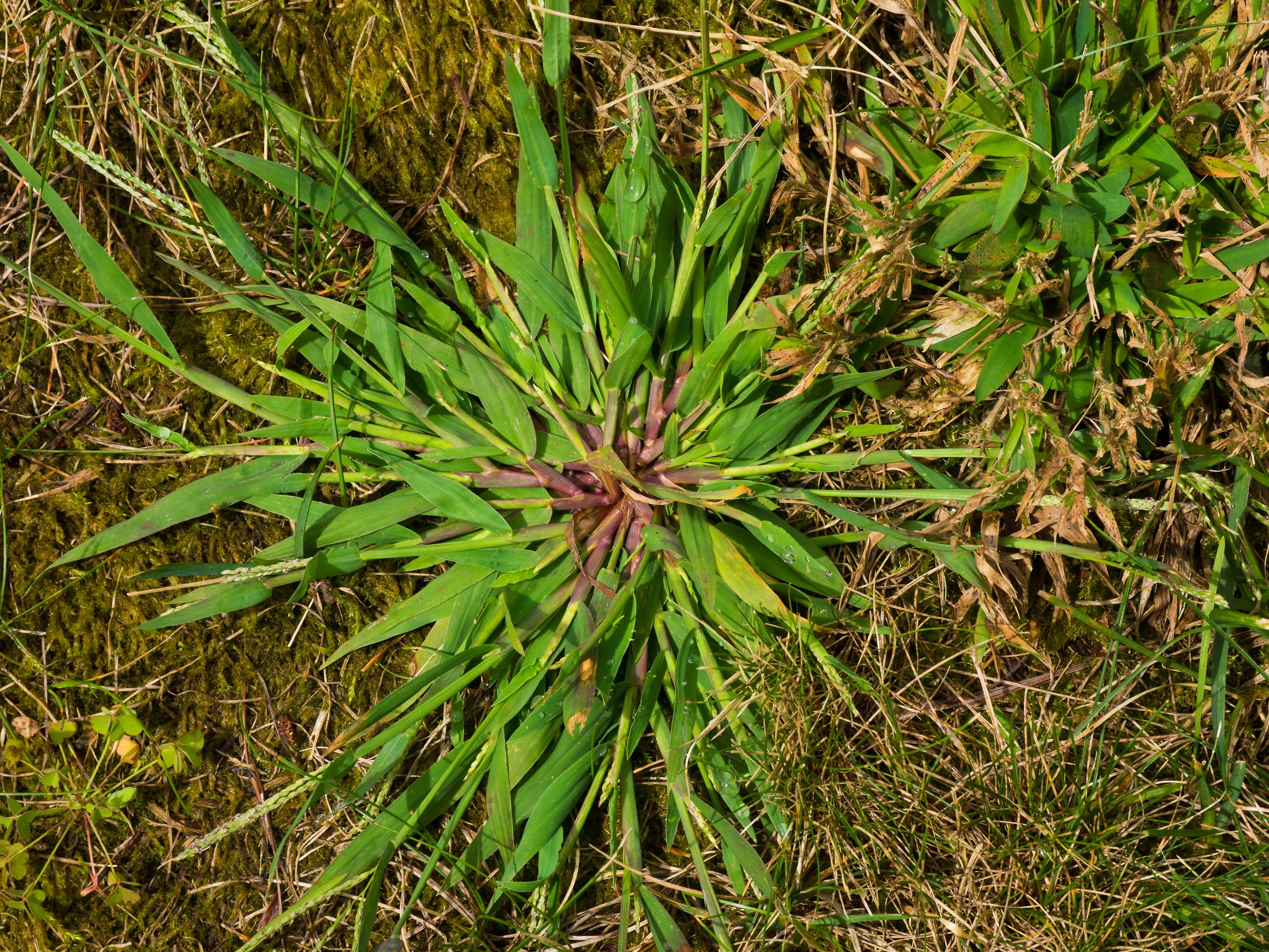
Annual and biennial weeds won’t sprout back after being hand-pulled from the ground, provided they are removed before they start flowering or seeding. However, this method doesn’t work with perennial weeds as it requires an additional chemical application via the appropriate herbicide. It may take up to 3 to 4 years of handling, and even then, it’s not guaranteed to eliminate the weeds.
Hand-pulling annual or biennial weeds from the ground or applying herbicide is enough to remove them permanently. But perennial weeds are different, as it takes more effort and time to control. They may never go away, but they’re not impossible to manage.
Japanese knotweed, Canada thistle, and Field Bindweed are some of the impossible weeds to get rid of due to their aggressive spreading and regenerative abilities. These are all perennial weeds and are generally the most challenging type to eliminate completely. As mentioned in this article, combining two or more methods is the best way to handle their growth to prevent overspreading.
References:
- admin. (2015, May 14). A Guide to Weed Life Cycles. Center for Agriculture, Food, and the Environment. https://ag.umass.edu/turf/fact-sheets/guide-to-weed-life-cycles
- Aegopodium podagraria (Bishop’s goutweed, Bishops’ Weed, Bishopweed, Gout Weed, Ground Elder, Herb Gerard, Snow on the mountain) | North Carolina Extension Gardener Plant Toolbox. (n.d.). Plants.ces.ncsu.edu. Retrieved January 13, 2023, from https://plants.ces.ncsu.edu/plants/aegopodium-podagraria/
- Bindweed | Backyard Farmer | Nebraska. (n.d.). Byf.unl.edu. Retrieved January 13, 2023, from https://byf.unl.edu/bindweed
- Bindweed: Noxious Weed. (n.d.). Www.johnson.k-State.edu. Retrieved January 13, 2023, from https://www.johnson.k-state.edu/lawn-garden/agent-articles/weeds/bindweed.html
- Blackseed Plantain. (n.d.). Turf.ces.ncsu.edu. Retrieved January 13, 2023, from https://www.turffiles.ncsu.edu/weeds-in-turf/blackseed-plantain/
- Broadleaf Plantain | Purdue University Turfgrass Science at Purdue University. (n.d.). https://turf.purdue.edu/broadleaf-plantain/
- Canada Thistle – 3.108 – Extension. (2018). Extension. https://extension.colostate.edu/topic-areas/natural-resources/canada-thistle-3-108/
- Canada thistle. (n.d.). Extension.umn.edu. https://extension.umn.edu/identify-invasive-species/canada-thistle
- Canada thistle. (n.d.). Weeds. https://www.canr.msu.edu/weeds/extension/canada-thistle
- Dandelion. (2020). Weeds. https://www.canr.msu.edu/weeds/extension/dandelion
- Extension | Canada Thistle. (n.d.). Extension.wvu.edu. Retrieved January 13, 2023, from https://extension.wvu.edu/lawn-gardening-pests/weeds/canada-thistle
- Extension | Ground Ivy. (n.d.). Extension.wvu.edu. https://extension.wvu.edu/lawn-gardening-pests/weeds/ground-ivy
- Ground elder / RHS Gardening. (n.d.). Www.rhs.org.uk. Retrieved January 13, 2023, from https://www.rhs.org.uk/weeds/ground-elder
- Ground Ivy | Purdue University Turfgrass Science at Purdue University. (n.d.). Retrieved January 13, 2023, from https://turf.purdue.edu/ground-ivy/
- Ground Ivy. (n.d.). Turf.ces.ncsu.edu. Retrieved January 13, 2023, from https://www.turffiles.ncsu.edu/weeds-in-turf/ground-ivy/
- Japanese knotweed. (n.d.). Extension.umn.edu. https://extension.umn.edu/identify-invasive-species/japanese-knotweed
- Japanese Knotweed. (n.d.). Penn State Extension. https://extension.psu.edu/japanese-knotweed
- Knotweed (Invasive). (n.d.). Solvepest. Retrieved January 13, 2023, from https://solvepestproblems.oregonstate.edu/weeds/knotweeds-invasive
- Lawn and Turfgrass Weeds: Yellow Nutsedge (Cyperus esculentus). (2022). Psu.edu. https://extension.psu.edu/lawn-and-turfgrass-weeds-yellow-nutsedge-cyperus-esculentus
- Leafy Spurge – 3.107. (n.d.). Extension. https://extension.colostate.edu/topic-areas/natural-resources/leafy-spurge-3-107/
- Leafy spurge | Integrated Crop Management. (n.d.). Crops.extension.iastate.edu. Retrieved January 13, 2023, from https://crops.extension.iastate.edu/encyclopedia/leafy-spurge
- Leafy Spurge | Nebraska Extension. (n.d.). Extension.unl.edu. Retrieved January 13, 2023, from https://extension.unl.edu/statewide/cedar/leafy-spurge-0/
- Leafy spurge. (n.d.). Extension.umn.edu. https://extension.umn.edu/identify-invasive-species/leafy-spurge
- Mahr, S. (n.d.). Dandelion, Taraxacum officinale. Wisconsin Horticulture. https://hort.extension.wisc.edu/articles/dandelion-taraxacum-officinale/
- Nov 4, F. | H. 2301 | P., & Download, 2019 | P. |. (n.d.). Broadleaf Weeds. Home & Garden Information Center | Clemson University, South Carolina. https://hgic.clemson.edu/factsheet/broadleaf-weeds/
- Phragmites (Common Reed). (n.d.). Www.michigan.gov. Retrieved January 13, 2023, from https://www.michigan.gov/invasives/id-report/plants/aquatic/phragmites-common-reed
- Phragmites, Common Reed (Phragmites australis) | Connecticut Invasive Plant Working Group. (2014, April 3). https://cipwg.uconn.edu/phragmites/
- Plantain Management Guidelines–UC IPM. (n.d.). Ipm.ucanr.edu. Retrieved January 13, 2023, from https://ipm.ucanr.edu/PMG/PESTNOTES/pn7478.html
- Quackgrass – Turfgrass Science at Purdue University – Purdue University. (n.d.). https://turf.purdue.edu/quackgrass/
- Quackgrass- Elymus repens. (n.d.). Plant & Pest Diagnostics. Retrieved January 13, 2023, from https://www.canr.msu.edu/resources/quackgrass-elymus-repens/
- Quackgrass. (n.d.). Extension.usu.edu. Retrieved January 13, 2023, from https://extension.usu.edu/rangeplants/grasses-and-grasslikes/quackgrass
- Quackgrass. (n.d.). Turf. Retrieved January 13, 2023, from https://www.canr.msu.edu/ipm/diseases/quackgrass
- Quackgrass. (n.d.). Weeds. https://www.canr.msu.edu/weeds/extension/quackgrass
- Weed Gallery: Field bindweed–UC IPM. (n.d.). Ipm.ucanr.edu. Retrieved January 13, 2023, from https://ipm.ucanr.edu/PMG/WEEDS/field_bindweed.html
- Yellow Nutsedge | Purdue University Turfgrass Science at Purdue University. (n.d.). Retrieved January 13, 2023, from https://turf.purdue.edu/yellow-nutsedge/
- Yellow Nutsedge. (n.d.). Turf.ces.ncsu.edu. Retrieved January 13, 2023, from https://www.turffiles.ncsu.edu/weeds-in-turf/yellow-nutsedge/

